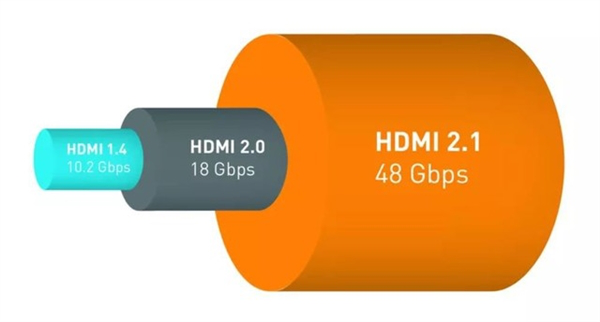Small interfaces are very important. From video to audio, it is fatal if the interface specifications are not advanced enough!
In order to better serve our eyes, so that we can get a better viewing experience, the improvement of display technology is mainly aimed at clearer pictures.
Of course, the improvement of the definition of video signals and presentation equipment is far from being as simple as "resolution."
To achieve this goal, there are often some parts that are easy to overlook in our daily life, but also have a vital role, such as a small interface.
When it comes to the importance of device interfaces, honestly speaking, input and output devices are equipped with appropriate interface configurations as much as possible at the beginning of their design.
Take the display device as an example. The resolution and refresh rate supported by the panel will generally be equipped with matching interface specifications. When relevant products are shipped from the factory, they are often equipped with a more reasonable solution designed by the manufacturer. Most of the time, users are not required to overdo it.
Do you think a 4K TV is enough? Foolish dreams!
When the resolution of the video signal is increased, the data volume of the signal will increase. The data volume of 3,820x2,160 4K UltraHD signals sent via HDMI is approximately 4 times that of HD 1,920x1,080 signals. If you think of the cable as a water pipe, you need a water pipe larger than 1080p to transmit 4K signals. There may be more links that affect the final picture than you think.
Let's simulate a scene. If we use a Blu-ray player + a TV to form a playback environment, what we need to pay attention to:
1. Have a Blu-ray player that supports 4K decoding (a playback device that can decode the source smoothly)
2. To have a qualified 4K Blu-ray original disc (ie: source with qualified bitrate)
3. The HDMI interface of the Blu-ray player must reach a certain version (4K 60Hz screen minimum HDMI 2.0, 4K 120Hz screen requires higher HDMI2.1)
4. The transmission cable needs to support the corresponding HDMI protocol (generally backward compatible, that is: HDMI 2.1 is compatible with all versions of HDMI 1.4-2.0)
5. The TV port interface needs to support the corresponding HDMI protocol (generally downward compatible, that is: HDMI 2.1 is compatible with all versions of HDMI 1.4-2.0)
6. The TV panel resolution and refresh rate need to meet the corresponding standards (4K60Hz or 4K120Hz)
With the above conditions, we can watch the true 4K resolution Blu-ray original disc.
What needs our users to pay attention to is that all the above conditions are indispensable.
HDMI announced the new HDMI 2.1 specification, the wire speed specification reached 48Gbps, allowing 8K/60 frames per second or 4K/120 frames per second image data to pass.
In addition, it can also bring gains to TVs equipped with this interface.
What is the necessity of HDMI 2.1 in the future TV standard?
What everyone is paying attention to is that this year's flagship TVs have been equipped with panels with a refresh rate of up to 120Hz. While maintaining the color performance, the high refresh rate panels can bring smoother screen display effects.
As we mentioned earlier, if you want to support 4K120Hz image transmission, the HDMI 2.1 interface is a necessary condition, and the HDMI 2.1 interface is equipped, and at the same time, the advantages of the interface's high data throughput need to be further utilized.

A high-refresh rate panel is a double-edged sword. We are analogy with a high-refresh rate gaming monitor. If the transition from a fast frame rate to a slow frame rate is too sudden.
The effect of screen tearing will occur, so Nvidia and AMD have introduced two technologies, G-Sync and Free-Sync, to improve this situation.
For TV products, there is a simpler and more direct way to improve this situation, which requires the use of another feature of HDMI 2.1-VRR (variable refresh rate).
The higher bandwidth of HDMI 2.1 can transmit more data, and it can also "coop" more chip-processing "small actions" in the data.
This year, many TVs are equipped with products that support the HDMI 2.1 interface protocol. In fact, to put it plainly is to improve the game performance.
In order to better adapt the product to the future gaming environment, HDMI 2.1 is still rare among the products at present.
At the same time, we need to note that the current two refresh rate specifications of 4K TVs, 60Hz and 120Hz, are just corresponding to the two interface specifications of HDMI 2.0 and HDMI 2.1.
This also means that the HDMI 2.1+ 120Hz refresh rate panel may become a small watershed between high and low end (at least game TV and ordinary TV).
Which product with HDMI 2.1 should I choose?
High-tech leading manufacturers represented by Samsung, Sony, and Hisense have already launched many TV products with higher specification interfaces this year.
Among them, the full line of Samsung TVs 8K + 120-240Hz is the "king of stockpiling", followed by the "partition backlight madman" Hisense.
More unexpectedly, this year Sony’s HDMI 2.1+120 Hz products are positioned as "entry-level."
However, there is a hole in the OLED product list to be filled. It should be completed after the launch of its own PS5 console. This product is very worth looking forward to.

















View More(Total0)Comment Lists